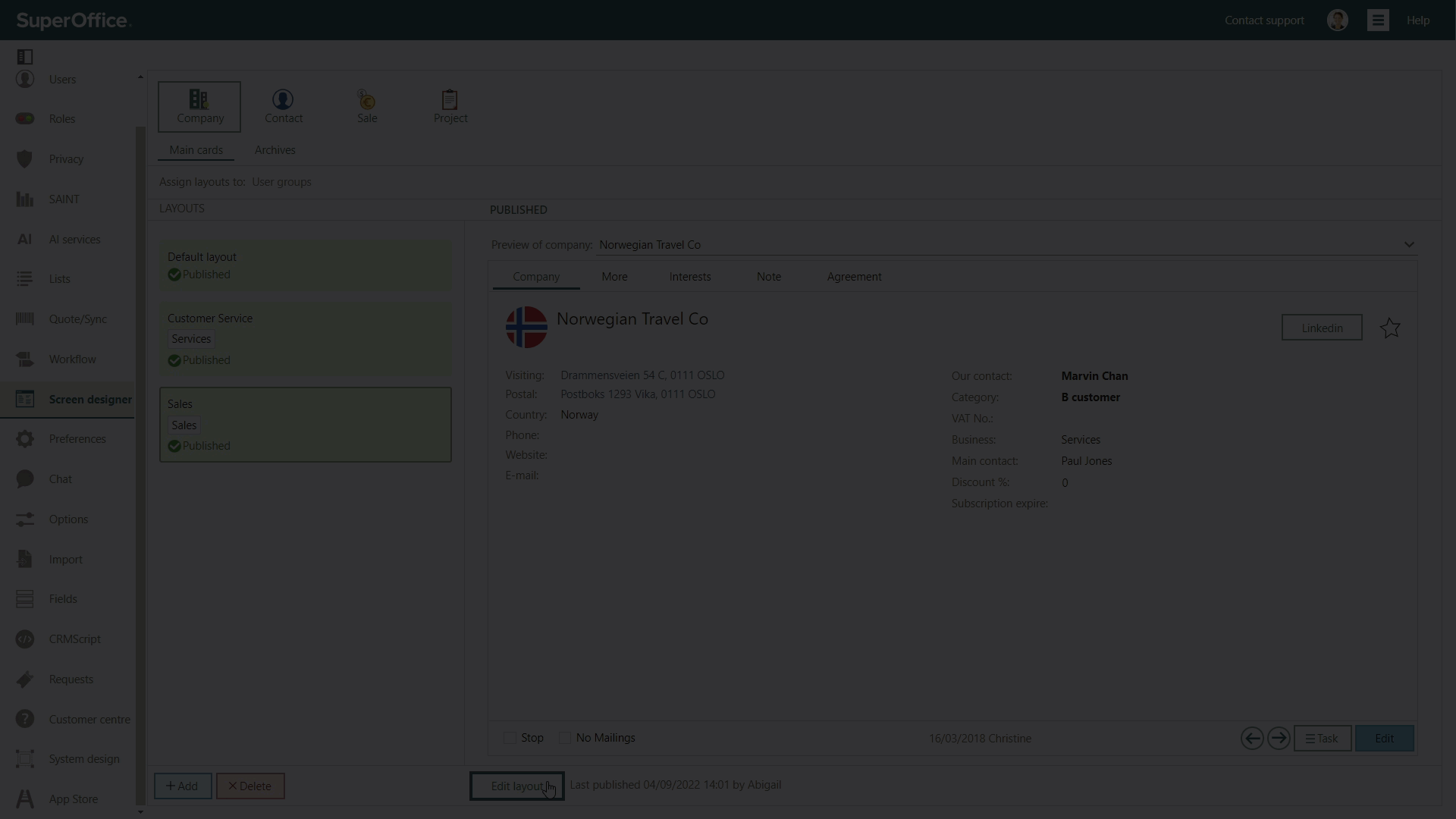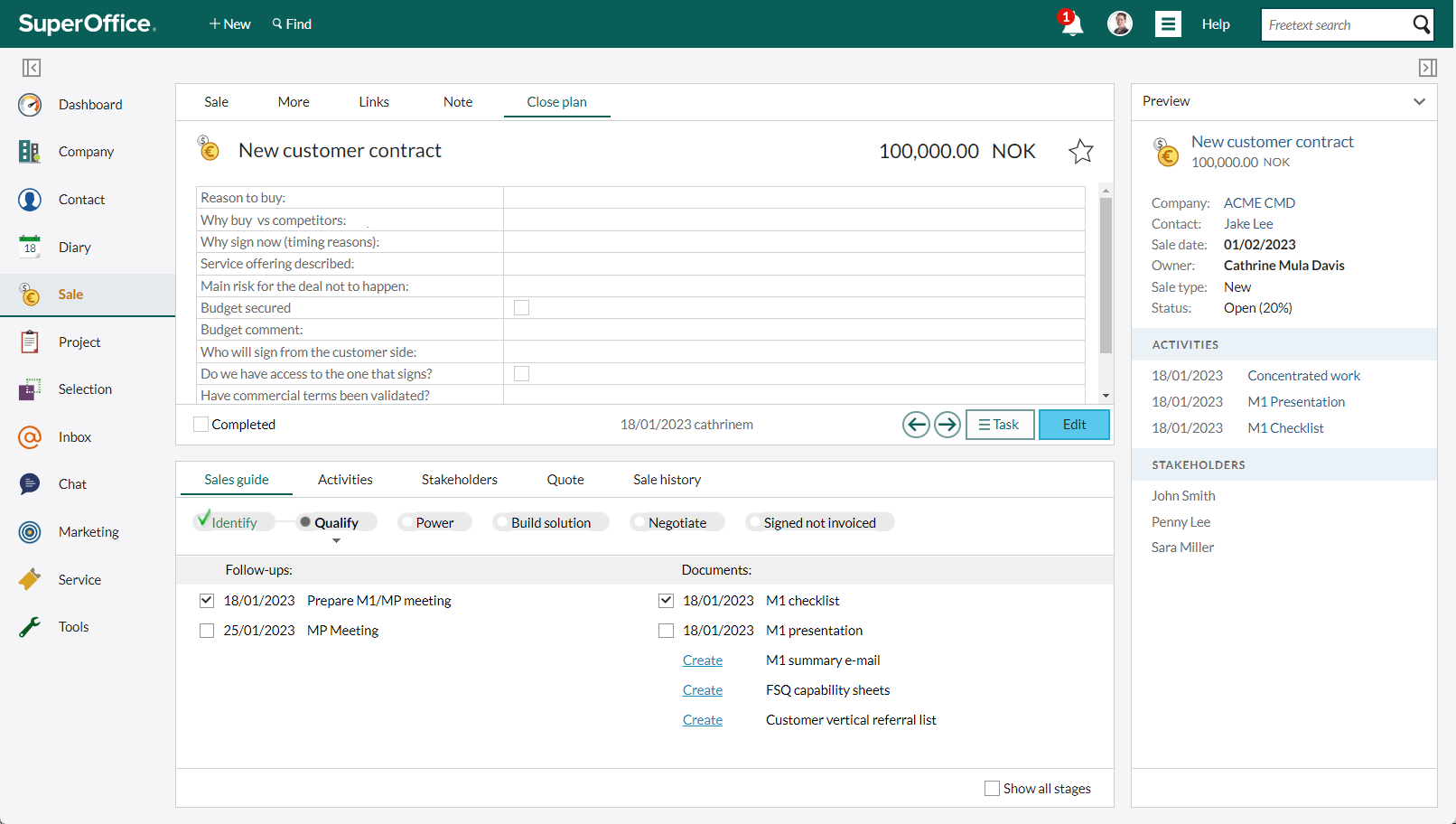No two businesses are the same, nor do they share the exact same problems.
Your business processes, your goals, and your approach to growth are the basis of what you bring to the market.
At the center of it is your CRM (or it should be) – the workflow-hub for different teams that support your vision and allow you to put your customer in the center of your growth strategy.
Whether you have just started on your CRM journey or have been working on your strategy for years, the key to customer centricity is to continuously evolve as the market and customers' needs evolve. Customer expectations are high. Adapting to new channels, touchpoints and strategies faster is a strong competitive advantage.
But how do you get there? 🤷
Your starting point is the customer journey: map out the experiences you want them to have with your company.
And whatever that journey looks like, you need to support it through your internal processes, strategies and solutions. To make sure you can achieve that, customizing your CRM (and any other) solution can make a real difference.
Making your CRM your own through customization
First, tailoring your CRM to fit your business will help you become more productive.
Addressing specific challenges with tailored workflows or automating repetitive tasks will help save time for the most important activities in your company. And you can build upon a robust standard solution like SuperOffice CRM, jumpstarting your success.
That was the case for Sharp UK. They needed a CRM that could be molded to their processes. With a complex B2B portfolio, they looked for a CRM that could grow with them, being flexible enough to fit into their specific needs. By choosing SuperOffice they were able from the very first days, which proved especially important during COVID-19, when everyone needed to adapt.
Like Sharp, a lot of companies look for a CRM solution that can drive productivity seamlessly with existing processes. Integrating existing solutions and customizing the CRM helps enabling unique customer experiences, an important source of competitive advantage.
Such is the case of Vitec AB in Sweden. They turned to SuperOffice to support their goal of providing unparalleled customer service. How are they achieving this? With customized self-service options that allow their support agents to spend time helping customers with more complex questions.
Making SuperOffice your own is a starting point for ensuring that your team uses the system. When people find useful information easily, see their templates and processes supported, then chances are they will adopt the solution and use it every day.
Getting started with customizations
As in all things CRM, the success of customization is a joint effort of business and technology.
Start with your business processes. Set a clear goal on how you’d like to improve it. Let’s say you want to improve the experience for a user group in your organization. You want them to have valuable information at hand to improve their readiness when talking to customers. And different user groups need different information.
Once you know what you want to achieve, the next step is understanding how. That means getting to know the possibilities of your CRM system. What is possible? How can you achieve what you want to do? What do you need to do?
At SuperOffice we have always believed that companies should be able to take charge of their own CRM solution. That your own people should be able to configure and adjust a lot of your solution without having to call upon your IT department or a consultant every time you want a change.
This focus on sustainable customization tools is a way to ensure flexibility and low cost of ownership.
And this is why we want to put a spotlight on the possibilities of low-code and no-code tools, sharing with you a few examples of what is possible to do with such technologies.
Low-code and no-code: empowering business with technology
As their name states, low-code and no-code require little or no involvement from software developers. These tools enable what are now called citizen developers to use visual interfaces, drag and drop menus and other solutions to create, change, and customize applications.

With low-code and no-code technology you can use visual tools, drag-and-drop menus and other alternatives to create and customize applications.
Low-code and no-code (LCNC) tools are here to stay. According to Gartner, by 2025, 70% of new applications will use this technology, a big leap from less than 25% in 2020.
The growth in LCNC is not by accident. Consider the sudden need for digitalization driven by COVID-19, the scarcity of software developers, and the “great resignation” phenomenon – and you have the perfect context for this popularity. But more than that, LCNC became popular because it offers real benefits to businesses, such as:
- Faster time-to-market: by adopting no-code tools, you need less time to define, test, implement, deploy, and get value from a customization or a new application.
- Less complexity: customizations can easily become too complex, needing too much effort from your team to make it work. With no-code, you get less complexity, and the possibility to tweak it as needed.
- Less maintenance: with standardized, already tested components, you will need to spend much less time on the maintenance side of things, allowing your software team to spend more time on creating value for your company. With visual tools, it is also easier to onboard new collaborators, spreading knowledge across the organization.
- Iteration: by using LCNC solutions you get to iterate faster, adjusting a workflow, or improving a specific area of your solutions as much as you need. You can also re-use components to prototype and speed development cycles.
⚡ Are you convinced by what LCNC technologies can do? See how you can use it in your SuperOffice CRM!
Most used no-code and low-code options in SuperOffice
The thing you should always have in mind when customizing a solution is: how can you make it sustainable?
With our sustainable customization strategy, we want customers to maintain and develop their own CRM solution as much as possible. It is no wonder, then, that we keep investing in no-code-low-code options, making them stronger and more flexible as recent technologies allow us.
Here are some examples of these customizations to inspire you:
-
Customizations for Sales teams
Define your sales processes via Sales Guides
Mirror your sales process in one or several sales guides, sharing the sales process with the whole team. The guide can automatically move deals from one stage to another while providing suggestions of documents, templates, and follow-up activities.
This is especially useful when you have new team members and want to get them up and running on your sales culture and processes. Have more than one guide and make them available to different teams as needed. Learn how to create a Sales guide here.

The above screenshot is an example of not only the Sales guide, but it also shows an example of how you can tailor screens to fit your different processes. In this case, the “Close plan” contains custom fields added in the admin module and designed with the use of Screen designer (see below for more details).
Monitor CRM data and act upon these using Sales Intelligence
By using Sales Intelligence (SAINT), you can choose to monitor key aspects of your CRM data. You can configure this feature to monitor, say customers that have not had any follow-up in a certain period and then visually alert colleagues that they need to reach out.
The options for what you monitor are many and you can configure how to alert your users and what actions you want them to take to fit your different business purposes. This feature is particularly useful for making sure no customers are left without a follow-up and that your most important customers have regular meetings with your team.
-
Customizations for Service teams
Automated escalation in SuperOffice Service
If you are using SuperOffice Service, you can set automated escalation rules for your incoming requests. That means that if a request is not answered within a time limit, it is automatically escalated, and people receive a warning that they need to act on it soon.
That way, you guarantee every customer receives the attention needed.
Cohesive experience in different channels
Make sure your customers get a cohesive experience no matter in what channel they reach out to your company.
You can customize how chats, forms, and the customer center look and feel for customers via simple configuration options. So, if your customers reach out to your team with, let’s say, a request on a product, no matter the channel they will get the right answer.
-
General system customizations
Configuration options in the Setting and maintenance module
As a CRM administrator you can set templates, create and edit lists, fields, templates, add your own custom fields and web panels, and more.
If you haven’t already or it’s been a while, get some training to help you better understand the possibilities and customize with confidence. You can also check out the many user guides for administrators here.
Define the layout of SuperOffice CRM with the Screen Designer*
You can visually customize your Company, Contact, Sales and Projects screens. Highlight selected fields to different user groups and in distinct types of projects and sales. That way, you make sure everyone has the best information in their hands.
*This feature requires a subscription to the add-on Development Tools.
Set up workflows inside SuperOffice CRM by using Macros
Create powerful if-this-than-that workflows with specific triggers. Use the Macros feature to automate repetitive tasks. Allow your team to focus on what matters most – your customer.

Inside Settings and maintenance you can define Macros which can be described as user-friendly version of scripts. Use the wizard and create simple "if-this-then-that workflows" within SuperOffice CRM.
CRMScripting*
CRMScripting is a scripting language embedded in SuperOffice CRM. They can help you automate more complex workflows. It requires more technical expertise, but the option for customizing is highly flexible, making CRMScripting a powerful tool to customize your solution.
Scripts are often used to automate workflows that have many steps. For example, you can let the script update data fields, insert follow-up activities in someone’s diary or send a mailing back to confirm automatically, and so on, when the script is triggered (for example, by someone sending in a form).
*This feature requires a subscription to the add-on Development Tools.
Learn more about how to set up these customization options here
-
Customizations using apps
Connect with other applications via SuperOffice Databridge and standard integrations
Shuffle through our App Store and get a variety of tested and certified apps to expand your CRM capabilities. There are plenty of apps that present added functions like contract management or digital signature that help you make the user experience seamless.
You can connect different systems such as your ERP to get a full view of all data about your customers base, or a company calendar, or a shared documents management solution, and more. By integrating SuperOffice CRM, you often reduce manual data entry, protect data quality and reduce the challenges that come from information silos.
You can also use standard integration tools to connect SuperOffice with other business applications of your choice.
One such highly used integration tool is Databridge for SuperOffice – that allows you to set up scheduled import and export flows with other applications without the need for custom code. Another is the Zapier Integration which lets you connect with thousands of other business applications and automate information flows between them by creating if-this-then-that workflows.
You can also create your own custom app with the use of our well documented APIs and Expander Services tools.
See examples on how to customize your SuperOffice CRM
Looking for inspiration? Check out the webcast "Tailor SuperOffice to drive CRM Success" and see examples of customizations to help you do even more with your CRM solution.
Keep on adapting SuperOffice CRM as you grow
Driving CRM success is an ongoing, continuous effort that needs people, business processes and technology working together. To truly make your customer the center of your growth strategy requires adaptations, and your CRM needs to be flexible enough to allow you to keep growing and evolving.
Customizing your CRM can help you achieve a lot: from ensuring user adoption by catering to specific needs within your teams, to improving productivity and reducing manual tasks, there is a lot you can do.
And remember – the best way to start is by having a clear goal and understanding of your business processes. With that in mind, get to know the customization possibilities your solution offers or get help from our consultants to identify options.
Once you know what you want to achieve and how you can do it, go for it! And when you start customizing your solution, make sure to iterate it, keep improving on what you have, and create value quickly and constantly.
Tip: You can safely create your customizations in a test environment which mirrors your SuperOffice CRM configuration first. There you can test it and train users without risking any issues with your actual production data.
Whether you choose a low-code or no-code approach, feel like you can expand functionality with integrations or see the opportunity of creating your own custom application through APIs, we have the set of tools and experience you need to make the most out of your CRM.
Get in touch and let’s explore the best options for you.
